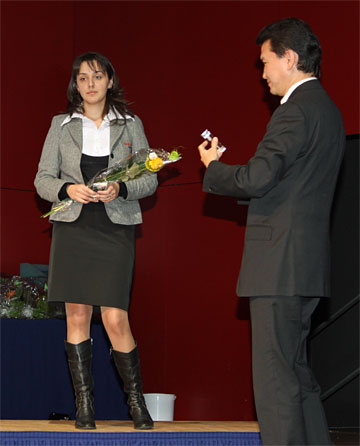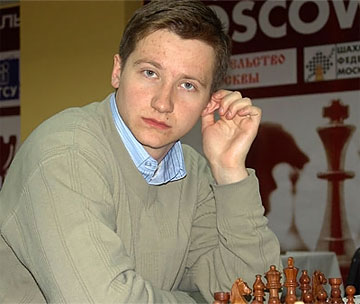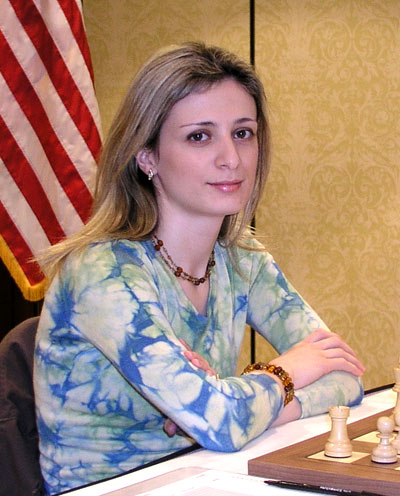| Latest | Greatest | Lobby | Journals | Search | Options | Help | Login |
|
|
|
This topic is archived. |
| Home » Discuss » Topic Forums » Sports |
|
| Jack Rabbit
|
Mon Dec-08-08 05:38 AM Original message |
| The Jack Rabbit Chess Report (December 7): The FIDE Follies |
|
The FIDE Follies
 Kirsan Ilyumzhinov is the George W. Bush of chess. OK, I know. That one's getting old. So is Kirsan's autocracy over FIDE. At the close of the 38th Olympiad in Dresden last week, FIDE had an annoucement to make about the current world championship cycle. Kirsan is changing the rules at his pleasure again. It's all a little confusing. The next challenger ofr the world championship is supposed to be chosen in a series of six Grand Prix tournaments. Except now it looks like there will only be four Grand Prix tournaments. The system is crubling finacially. So Kirsan has chosen to introuduce a new system without asking the players who have been competing in the Grand Prix what they think about it. Magnus Carlsen, who turned eighteen as the Dresden games completed, announced his withdrawal from the Grand Prix. Levon Aronian has suggested the Kirsan review the decision, and reverse it. Alexei Shirov has suggested banning FIDE. That may be the best idea of all. Meanwhile, grandmaster Vassily Ivanchuk refused to take a drug test after game in Dresden which he lost. FIDE is threatening the popular Ukrainian GM with a two year ban from chess. Calendar Russian Women's Championship, Moscow 5-14 December. International Tournament, Nanjing 10-22 December. This promises to be the first of a new annual elite tournament. Participants: Topalov, Ivanchuk, Aronian, Movsesian, Svidler, Bu. FIDE Grand Prix, Asian Club Cup, Al Ain (UAE) 24-31 December. Hasting Chess Tournament 28 December 2008-5 January 2009. Rilton Cup, Stockholm 28 December 2008-5 January 2009. Corus Chess Tournament, Wijk aan Zee 16 January-1 February. Gibraltar Chess Festival 27 January-5 February. FIDE Grand Prix, Moscow 30 January-8 February. Aeroflot Open, Moscow 16-27 February. Topalov-Kamsky World Championship Semifinal Match, Sofia 16-28 February. Eight Rounds. Winner will challenge Anand for the world championship. Linares Grandmaaster Tournament 18 February-8 March. European Individual Championships, Budva (Montenegro) 5-19 March. |
| Printer Friendly | Permalink | | Top |
| Jack Rabbit
|
Mon Dec-08-08 05:39 AM Response to Original message |
| 1. This week's games. |
|
Your humble hare acknowledges the assistance of Fritz 6.0 on analysis. Diagrams on the Jack Rabbit Chess Report are made with Chess M�rida, a true type font that can be downlaoded free here. !""""""""# $tMvWlVmT% $OoOoOoOo% $ + + + +% $+ + + + % $ + + + +% $+ + + + % $pPpPpPpP% $RnBqKbNr% /(((((((() WHITE White to move (This position is a theoretical draw) |
| Printer Friendly | Permalink | | Top |
| Jack Rabbit
|
Mon Dec-08-08 05:40 AM Response to Reply #1 |
| 2. Cuartas - Leko, Round 6, Dresden |
 Peter Leko Jaime Cuartas (Colombia) - Peter Leko (Hungary) 38th Olympiad (General Competition), Round 6/Board 1 Dresden, 19 November 2008 Spanish Grand Royal Game: Lasker's Exchange Opening 1.e4 e5 2.Nf3 Nc6 3.Bb5 a6 4.Bxc6 dxc6 5.Nc3
5...f6 6.d4 exd4 7.Qxd4
7...Qxd4 8.Nxd4 Bd7 9.f3
9...0-0-0 10.Kf2 Ne7 11.Be3 f5!?
12.exf5
12...Nxf5 13.Nxf5
13...Bxf5 14.Rac1 Be7 15.Ne2
15...c5 16.Ng3 Bg6 17.c3 b6 18.Rcd1 Bf7
19.Rxd8+ Rxd8 20.Ra1?!
20...Bh4 21.Bf4 Kb7 22.Kg1 Re8!?
23.Ne4!
23...Bd5 24.g3 Bd8 25.Re1 Kc6
26.a3 g5 27.Bd2 g4 28.Kf2 gxf3
29.Ng5?!
!""""""""# $ + Vt+ +% $+ O + +o% $oOl+ + +% $+ Ov+ N % $ + + + +% $p P +oP % $ P B K P% $+ + R + % /(((((((() WHITE: Jaime Cuartas Position after 29.Ne4g5 29...Rxe1!
30.Kxe1 h5
31.a4?
31...b5 32.axb5+ Kxb5!
33.Nh3
33...Kc4 34.Kd1
34...Kb3 35.Kc1 Bf6 36.Nf2
36...a5 37.Be3 c4 38.h4
38...a4 39.Nd1 Be4 40.Nf2
40...Bf5!
41.Nd1 Bc2 42.Nf2
!""""""""# $ + + + +% $+ O + + % $ + + V +% $+ + + +o% $o+o+ + P% $+lP BoP % $ Pv+ N +% $+ K + + % /(((((((() WHITE: Jaime Cuartas Position after 42.Nd1f2 42...Bxc3!!
43.bxc3 a3 0-1
|
| Printer Friendly | Permalink | | Top |
| Jack Rabbit
|
Mon Dec-08-08 05:42 AM Response to Reply #1 |
| 3. Nakamura - Bruz�n, Round 6, Dresden |
 Hikaru Nakamura Hikaru Nakamura (United States) - L�zaro Bruz�n (Cuba) 38th Olympiad (General Competition), Round 6/Board 2 Dresden, 19 November 2008 Semi-Slav Queen's Gambit: Marshall Opening 1.d4 d5 2.c4 c6 3.Nf3
3...Nf6 4.Nc3 dxc4 5.a4 e6 6.e4
6...Bb4 7.e5
7...Nd5 8.Bd2 b5 9.axb5 Bxc3 10.bxc3 cxb5 11.Ng5 Nc6
12.Qh5
12...Qe7 13.Ne4!?
13...0-0 14.Bg5
14...f6 15.exf6 gxf6 16.Bh6
16...Rd8 17.Be2
17...e5 18.0-0
18...Qf7 19.Qh4!?
19...Bf5?!
20.Ra6
20...Bxe4 21.Rxc6!
21...Nf4 22.Rxf6 Nxe2+
23.Kh1 Qb7
24.Qg5+ Bg6?
!""""""""# $t+ T +l+% $Ow+ + +o% $ + + RvB% $+o+ O Q % $ +oP + +% $+ P + + % $ + +mPpP% $+ + +r+k% /(((((((() WHITE: Hikaru Nakamura Position after 24...Be4g6 25.Rxg6+!!
25...hxg6 26.Qxg6+ Kh8 27.Bg5
27...Rf8
28.Bf6+
28...Rxf6 29.Qxf6+ Kg8 30.Qe6+ Qf7
31.Qg4+ Qg7 32.Qxe2 exd4 33.cxd4
33...Rd8?
34.Rb1?!
34...Qxd4 35.Qe6+ Kg7 36.Qe7+ Kh8 !""""""""# $ + T + L% $O + Q + % $ + + + +% $+o+ + + % $ +oW + +% $+ + + + % $ + + PpP% $+r+ + +k% /(((((((() WHITE: Hikaru Nakamura Position after 36...Kg7h8 37.h3!
37...a6
38.Re1 c3 39.Re5
39...Qd1+ 40.Kh2 Qd6 41.Qh4+ Kg7 42.Qg3+ Kf6
43.f4 c2
!""""""""# $ + T + +% $+ + + + % $o+ W L +% $+ + R + % $ + + P +% $+ + + Qp% $ +o+ +pK% $+ + + + % /(((((((() WHITE: Hikaru Nakamura Position after 43...c3c2 44.Qg5+!
44...Kf7 45.Qf5+ Kg7 46.Qxc2 Rf8
47.Rg5+ Kf7 48.Qh7+ Ke8
49.Re5+ Kd8 50.Qb7 1-0
|
| Printer Friendly | Permalink | | Top |
| Jack Rabbit
|
Mon Dec-08-08 05:44 AM Response to Reply #1 |
| 4. Lomineishvili - Vega, Round 7, Dresden |
 Maia Lomineishvili receiving her bronze medal for individual performance on baord 4 from FIDE President Kirsan Ilyumzhinov Maia Lomineishvili (Georgia) - Sabrina Vega (Spain) 38th Olympiad (Women's Competition), Round 7/Board 3 Dresden, 20 November 2008 Semi-Slav Queen's Gambit: Meran Defense 1.d4 d5 2.c4 e6 3.Nc3 c6 4.e3 Nf6 5.Nf3 Nbd7 6.Bd3 dxc4 7.Bxc4 b5 8.Bd3 Bd6
9.Qc2 Bb7 10.0-0 0-0 11.Rd1
11...Qb8!?
12.h3
12...Re8 13.Ng5 h6 14.Nge4 Bf8?!
15.b3 Nxe4 16.Nxe4 e5 17.Bb2
17...exd4 18.Bxd4 c5?
19.Nxc5 Nxc5 20.Bxc5 Rc8
!""""""""# $tWt+ Vl+% $Ov+ +oO % $ + + + O% $+oB + + % $ + + + +% $+p+bP +p% $p+q+ Pp+% $R +r+ K % /(((((((() WHITE: Maia Lomineishvili Position after 20...Re8c8 21.b4!
21...Bxc5 22.bxc5 Qe5 23.Rac1
23...a6
24.Bh7+ Kf8 25.Bf5
25...Rc7 26.Rd4 Re8 27.Bd7 Rd8 28.c6 Bc8
29.Rcd1 g6
30.Rd5 Qe7 31.Qc3
31...Kg8 32.Qa5 Ra7 33.Qb6
33...Ra8 34.c7 Rxd7 35.Rxd7 Bxd7 36.Qb8+!
36...Qf8
!""""""""# $tQ + Wl+% $+ Pv+o+ % $o+ + +oO% $+o+ + + % $ + + + +% $+ + O +o% $o+ + oo+% $+ +r+ K % /(((((((() WHITE: Maia Lomineishvili Position after 36...Qe7f8 37.Qxa8!!
37...Qxa8 38.Rxd7 1-0
|
| Printer Friendly | Permalink | | Top |
| Jack Rabbit
|
Mon Dec-08-08 05:45 AM Response to Reply #1 |
| 5. Linares - Partac, Round 7, Dresden |
 Oleiny Linares Oleiny Linares (Cuba) - Elena Partac (Moldova) 38th Olympiad (Women's Competition), Round 7/Board 4 Dresden, 20 November 2008 Open Sicilian Game: Royal Dragon Defense 1.e4 c5 2.Nf3 Nc6 3.d4 cxd4 4.Nxd4 g6 5.Nc3 Bg7 6.Nb3
6...Nf6 7.Be2 d6 8.0-0 0-0 9.Re1
9...Be6
10.Bf1
10...Re8!?
11.Nd5
11...Bxd5?!
12.exd5 Nb4 13.c4 Qd7
14.a3 Na6 15.Be3 Nc7 16.Rc1
16...e6 17.dxe6
17...Nxe6 18.Qf3 Qa4?!
19.Nd4 d5?
!""""""""# $t+ +t+l+% $Oo+ +oVo% $ + +mMo+% $+ +o+ + % $w+pN + +% $P + Bq+ % $ P + PpP% $+ R RbK % /(((((((() WHITE: Oleiny Linares Position after 19...d6d5 20.Nxe6!
20...fxe6 21.Bd4 Qd7
22.Bxf6 Rf8 23.cxd5!
23...Rxf6 24.dxe6 Qe7
25.Qg3 Rf5 26.Rc7 Qf6
!""""""""# $t+ + +l+% $OoR + Vo% $ + +pWo+% $+ + +t+ % $ + + + +% $P + + Q % $ P + PpP% $+ + RbK % /(((((((() WHITE: Oleiny Linares Position after 26...Qe7f6 27.e7! 27...Re8 28.Qb3+ Kh8 29.Qa4 b5 30.Qxa7 Qxb2 31.Rd1 Qb3 32.Rd8 Qf7 33.Rcc8 1-0 |
| Printer Friendly | Permalink | | Top |
| Jack Rabbit
|
Mon Dec-08-08 05:47 AM Response to Reply #1 |
| 6. Petrenko - Chiburdanidze, Round 8, Dresden |
|
Maia Chibudanidze, the former long-reigning women's world champion, won a gold medal for her individual performance on board 1. This was the first of four consecutive victories for Mme. Chibudanidze that propelled the Georgian women's team to the gold medal. Among her victims: reigning women's champion Alexandra Kosteniuk and the phenomenal Chinese prodigy Hou Yifan.
 Maia Chiburdanidze Maia Chiburdanidze (Georgia) - Svetlana Petrenko (Moldova) 38th Olympiad (Women's Competition), Round 8/Board 1 Dresden, 21 November 2008 Open German Game: Main Line 1.e4 c6 2.d4 d5 3.Nc3 dxe4 4.Nxe4 Bf5 5.Ng3 Bg6 6.h4 h6 7.h5 Bh7 8.Nf3 Nd7 9.Bd3 Bxd3 10.Qxd3 Ngf6 11.Bd2
11...e6 12.c4
12...b5!?
13.cxb5 cxb5 14.Qxb5
14...Bd6
15.Ne5 Qb8
16.Qxb8+
16...Rxb8 17.Bc3
17...Nd5 18.Nc4!?
18...Bxg3!
19.fxg3 Ke7 20.Kd2
20...Rhc8 21.Kd3 f5!?
!""""""""# $ Tt+ + +% $O +mL O % $ + +o+ O% $+ +m+o+p% $ +nP + +% $+ Bk+ P % $pP + +p+% $R + + +r% /(((((((() WHITE: Svetlana Petrenko Position after 21...f7f5 22.Rae1!
22...N7f6 23.Rh4 Nxc3
24.bxc3 Nd5!
25.Rc1 Rc7 26.Ne3 Nxe3
27.Kxe3 !""""""""# $ T + + +% $O T L O % $ + +o+ O% $+ + +o+p% $ + P + R% $+ P K P % $p+ + +p+% $+ R + + % /(((((((() WHITE: Svetlana Petrenko Position after 27.Kd3e3:N 27...Rb2!
28.g4?!
28...Rxg2 29.gxf5 exf5
30.a4 Kf6!?
31.d5 Ke5 32.c4!
32...Ra2 33.Re1 Kd6
34.Kd3
34...Ra3+ 35.Kd4?
!""""""""# $ + + + +% $O T + O % $ + L + O% $+ +p+o+p% $p+pK + R% $T + + + % $ + + + +% $+ + + + % /(((((((() WHITE: Svetlana Petrenko Position after 35.Kd3d4 35...Rxc4+!!
36.Kxc4 Rxa4+
37.Kd3 Rxh4
38.Rg1
38...Rg4 39.Ra1
39...Kxd5 40.Ra5+ Ke6 41.Ra6+
41...Kf7 42.Ke3 Kg8 0-1
|
| Printer Friendly | Permalink | | Top |
| Jack Rabbit
|
Mon Dec-08-08 05:50 AM Response to Reply #1 |
| 7. Efimenko - Morozevich, Round 9, Dresden |
|
This game ended the hopes of the Russian general team for a Gold Medal.
 Zahar Efimenko Zahar Efimenko (Ukraine) - Alexander Morozevich (Russia) 38th Olympiad (General Competition), Round 9/Board 4 Dresden, 22 November 2008 French Game: Tarrasch Opening (Morozevich Defense) 1.e4 e6 2.d4 d5 3.Nd2 Be7
4.Bd3 c5 5.dxc5 Nf6 6.Qe2 Nc6
7.Ngf3 Bxc5
8.0-0 Qc7
9.c4
9...dxc4 10.Bxc4!?
10...Ng4!?
11.h3 h5?!
!""""""""# $t+v+l+ T% $OoW +oO % $ +m+o+ +% $+ V + +o% $ +b+p+m+% $+ + +n+p% $pP NqPp+% $T B +rK % /(((((((() WHITE: Zahar Efimenko Position after 11...h7h5 12.b4!?
12...Bd4?
13.Rb1!
13...Bd7
14.b5 Ne7
!""""""""# $t+ +l+ T% $OoWvMoO % $ + +o+ +% $+p+ + +o% $ +bVp+m+% $+ + +n+p% $p+ NqPp+% $+rB +rK % /(((((((() WHITE: Zahar Efimenko Position after 14...Nc6e7 15.e5!
15...Bb6
16.Ba3 Nf5 17.Ne4 f6
18.Nd6+ Nxd6 19.exd6 Qd8
20.Bxe6 Kf8 21.Bxd7 Qxd7 !""""""""# $t+ + L T% $Oo+w+ O % $ V P O +% $+p+ + +o% $ + + +m+% $B + + + % $p+ +qPp+% $+r+ +r+ % /(((((((() WHITE: Zahar Efimenko Position after 21...Qd8d7:B 22.Qe7+!
22...Qxe7 23.dxe7+ Kf7
24.hxg4
24...hxg4 25.Nd2 g3 26.Nc4 Rh5
27.Nxb6 axb6 28.Rb3 gxf2+
29.Kxf2 Rd5 30.Re1 Ke8 31.Rc3 Kf7 1-0
|
| Printer Friendly | Permalink | | Top |
| Jack Rabbit
|
Mon Dec-08-08 05:52 AM Response to Reply #1 |
| 8. Tokhirjanova - Goletiani, Round 10, Dresden |
 Rusa Goletiani Hulkar Tokhirjanova (Uzbekistan) - Rusa Goletiani (United States) 38th Olympiad (Women's Competition), Round 10/Board 3 Dresden, 23 November 2008 Open Sicilian Game: Kan Defense (Polugaevsky Opening) 1.e4 c5 2.Nf3 e6 3.d4 cxd4 4.Nxd4 a6 5.Bd3
5...Bc5 6.Nb3 Be7
7.Qg4
7...g6 8.Qe2 d6 9.0-0 Nd7 10.Na3
10...Qc7
11.Nc4 b6 12.a4 Bb7
13.a5
13...b5 14.Nb6 Nxb6
15.axb6 Qxb6 16.Na5 Bc8 17.c4 b4 18.Be3!?
18...Qc7
19.f4?!
19...Bd7 20.e5 Nh6?!
21.g4 dxe5 22.fxe5 Bc5
23.Bxc5 Qxc5+ 24.Kh1
24...0-0 25.h3 Kg7!
26.Qe4 Rac8
27.Kh2 Qc7
28.Qf4 Ng8 29.g5 Qb8?!
!""""""""# $ Wt+ Tm+% $+ +v+oLo% $o+ +o+o+% $N + P P % $ Op+ Q +% $+ +b+ +p% $ P + + K% $R + +r+ % /(((((((() WHITE: Hulkar Tokhirjanova Position after 29...Qc7b8 30.Nb3!
30...Rc6
31.c5
31...Qc8?!
32.Qxb4?!
32...Ne7 33.Be4
33...Nd5 34.Qd4
34...Kg8
35.Rfc1 Qd8 36.Qd2 Qb8 37.Bxd5!
37...Qxe5+!?
38.Kg1?
38...exd5 39.Nd4 !""""""""# $ + + Tl+% $+ +v+o+o% $o+t+ +o+% $+ PoW P % $ + N + +% $+ + + +p% $ P Q + +% $R R + K % /(((((((() WHITE: Hulkar Tokhirjanova Position after 39.Nb3d4 39...Qg3+!
40.Kh1 Qxh3+
41.Qh2 Qe3 42.Qh4
42...Rc7?!
43.Rc3 Qe7 44.Re1
44...Qd8 45.c6 Bc8 46.Rf3 h5
47.Qf4 Bg4
48.Rfe3
48...Qc8 49.Re5
!""""""""# $ +w+ Tl+% $+ T +o+ % $o+p+ +o+% $+ +oR Po% $ + N Qv+% $+ + + + % $ P + + +% $+ + R +k% /(((((((() WHITE: Hulkar Tokhirjanova Position after 49.Re3e5 49...Rxc6!!
50.Nxc6 Qxc6
51.Qd4 Rc8
52.R5e3
52...Qd7!
53.Re7 Bf3+ 54.Kh2 Qd6+ 55.Qe5 Qxe5+
56.R1xe5 Rc2+ 57.Kg3 Be4 58.Ra7
58...Rxb2 59.Re8+ Kg7 60.Raa8
!""""""""# $r+ +r+ +% $+ + +oL % $o+ + +o+% $+ +o+ Po% $ + +v+ +% $+ + + K % $ T + + +% $+ + + + % /(((((((() WHITE: Hulkar Tokhirjanova Position after 60.Ra7a8 60...Rg2+!
61.Kh3
61...Rxg5 62.Rxa6
62...Rf5 63.Rd8 g5 64.Rdd6 Rf3+ 65.Kh2
65...h4 66.Rd8 Rf2+ 67.Kh3 Bf5# 0-1 |
| Printer Friendly | Permalink | | Top |
| Jack Rabbit
|
Mon Dec-08-08 02:39 PM Response to Original message |
| 9. Update (Monday): Hou Yifan named Grandmaster |
|
Hou Yifan became the youngest lady ever to earn the title of international grandmaster, a title once reserved for men, when the honor was conferred upon her by FIDE at the meeting of the federation's general assembly in Dresden in late November.
Hou Yifan Her accomplishments this year include first place in a strong women's tournament in Istanbul in March, third place in the World Junior Championships in Turkey in July (where she played in the "boys'" event), runner-up in the women's world championship tournament in Nalchik in September and a bronze medal for individual performance on the top board at the Dresden Olympiad in November. The young lady turns 15 next February 27. She is currently third among all women on the official rankings behind Koneru Humpy of India and Judit Polgar of Hungary. |
| Printer Friendly | Permalink | | Top |
| Jack Rabbit
|
Tue Dec-09-08 01:59 PM Response to Original message |
| 10. Update (Tuesday): Mickey Adams "apparently" withdraws from Grand Prix |
|
The website Chessdom.com reports today that British grandmaster Mickey Adams will not participate in the next leg of the FIDE Grand Prix in Elista starting next week, speculating that Adams has withdrawn from the Grand Prix altogether.
If it is true that Adams has withdrawn, then the Cornish grandmaster joins a growing list of top ranked chess players in revolt against FIDE and its President, Kirsan Ilyumzhinov, for the arrogant and high-handed manner in which the world championship cycle was modified with the cycle in progress. Grandmasters Alexei Shirov of Spain and Levon Aronian of Armenia have spoken out against the FIDE's latest action and 18-year-old Norwegian grandmaster Magnus Carlsen has withdrawn from the Grand Prix in protest. |
| Printer Friendly | Permalink | | Top |
| DU
AdBot (1000+ posts) |
Tue Apr 16th 2024, 08:04 AM Response to Original message |
| Advertisements [?] |
| Top |
| Home » Discuss » Topic Forums » Sports |
|
Powered by DCForum+ Version 1.1 Copyright 1997-2002 DCScripts.com
Software has been extensively modified by the DU administrators
Important Notices: By participating on this discussion board, visitors agree to abide by the rules outlined on our Rules page. Messages posted on the Democratic Underground Discussion Forums are the opinions of the individuals who post them, and do not necessarily represent the opinions of Democratic Underground, LLC.
Home | Discussion Forums | Journals | Store | Donate
About DU | Contact Us | Privacy Policy
Got a message for Democratic Underground? Click here to send us a message.
© 2001 - 2011 Democratic Underground, LLC